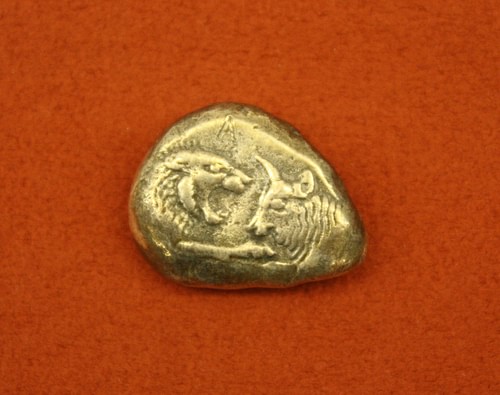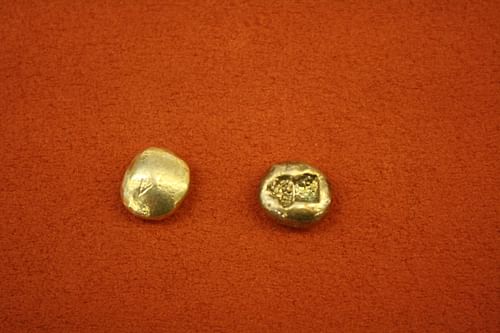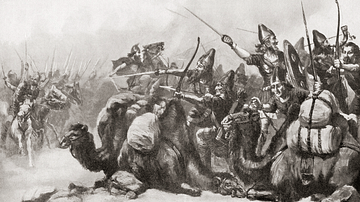The Lydian Stater was the official coin of the Lydian Empire, introduced before the kingdom fell to the Persian Empire. The earliest staters are believed to date to around the second half of the 7th century BCE, during the reign of King Alyattes (r. 619-560 BCE). According to a consensus of numismatic historians, the Lydian stater was the first coin officially issued by a government in world history and was the model for virtually all subsequent coinage.
Background on Ancient Commerce
Chiefly, in order for a coin to be legitimately considered such, it must clearly be issued by a governing authority. This distinguishes coins from tokens, barter items, and other limited forms of money. Though there are no requirements that a coin be made of metal, this is largely unavoidable for the coin to function as money (as a unit of account, an intermediary of exchange, and a store of value), as it must be portable, non-perishable, difficult to counterfeit, and confer value (whether intrinsically or by decree). Nineteenth-century historian Barclay V. Head observed that “the precious metals had long . . . commended themselves to the civilized peoples of the East as being the measure of value least liable to fluctuation, most compact in volume, and most directly convertible.”
Gold and silver were used as currency, as a means of facilitating commercial exchange, long before the first coins arose. Rings or ingots (bars) of precious metal were used by travelers and traders across the ancient world, but they had to be weighed and verified each time a transaction took place in order to reckon their value in trade. Coins, with their standardized weights, eliminated this time-consuming problem, rendering them a more efficient and expedient conduit of commerce.
It is fitting, and worth observing, that the Lydians engendered a mercantile culture; Herodotus acclaimed them (with exaggeration) as the world's first merchants, as they earned a reputation for being important interlocutors between East and West. In his monograph The Coinage of Lydia and Persia, Barclay Head noted “the spirit of commercial activity which the natives of Lydia possessed,” while another 19th-century historian, Ernst R. Curtius, compared their knack for playing middlemen to that of the Phoenicians: "The Lydians became on land what the Phoenicians were by sea, the mediators between Hellas [Greece] and Asia." With its strategic territorial expansion near the Bosporus and Hellespont (now the Dardanelles Strait), which effectively connect the Black Sea to the Aegean Sea, it is no surprise that the Lydian Empire of the late 7th - early 6th century BCE would be home to a thriving mercantile tradition. The Lydians even gave special status to merchants within their society: they were known as agoraios, or “People of the Market,” and enjoyed a higher rank than commoners in the social hierarchy.
It is, however, unclear that the earliest staters of Lydia actually circulated in commercial exchange. In archaeological sites near Sardis, for instance, there are no staters found in the ruins of shops and marketplaces. One would expect to find them here if they were spent as money within the kingdom. More likely, these coins were hoarded by the king and the wealthy, perhaps issued for the collection of taxes, and used in long-distance trade between Lydia and its neighbors, as many staters have been recovered from Ionian temples.
A Note About Historical Consensus
There are, however, competing historical theories about the first government-issued coins arising earlier in Greece, India, or China. In the latter two cases, most historians have concluded that although coinage likely sprung up in China and India independently from Lydia, the evidence suggests that these developments took place after the introduction of the stater. The case for Greece seems to owe itself largely to the Western bias of more contemporary historians. Nonetheless, it reveals that the true genesis of coins as money remains a disputed topic of historical inquiry.
Composition & Appearance of Lydian Coins
The Lydian stater was composed of electrum, a naturally-occurring gold-silver alloy; though the coins are often reported to be struck from this naturally-occurring alloy, they were actually made from a specific and rather consistent mix of approximately 55% gold, 45% silver, and a small balance of copper. This indicates that silver and copper were added to natural electrum in order to achieve a more durable and balanced metal alloy. Although the extra copper slightly debased the coin's intrinsic value, it allowed it to exhibit a golden hue, unlike the pale white-gold color of pure electrum.
There do exist cruder pieces struck in electrum that possibly predate the stater. These first electrum “pre-coins” were blank, bearing no emblem that tied them to an issuing authority. They sometimes featured striations on one side of the flan, which historians have speculated may harken to the electrum-rich Pactolus River that supplied the raw materials for these pieces. (The Pactolus was said to have acquired its metallic abundance when King Midas of nearby Phrygia bathed in its waters to remove his curse of the “golden touch.”) It appears, however, that many of the Asiatic Greek cultures — especially in Miletus (or Miletos) and Ionia, along the Aegean coast — were using, or perhaps experimenting with, these electrum blanks contemporaneously with the Lydians. It is the administrative innovations of Alyattes and his son Croesus (or Kroisos) which set the Lydian staters apart.
For numismatists and numismatic historians, the importance of Lydian coinage is the novel idea that striking or stamping a piece of precious metal with a “State seal” of sorts could confer official status on it as money, indicating the State's willingness to accept the piece as payment. This is the crucial feature that distinguishes Lydian staters from preceding forms of money and connects them to all subsequent coins.
Staters came in somewhat irregular shapes, many of them ovular or bean-shaped, but had a fairly consistent weight of 220 grains of wheat. (This measure is somewhat complicated by the variance between the wheat grains, barleycorns, and carob seeds that formed the basis for different weight standards in antiquity.) This weight is what defined a “stater.” In fact, all ancient coin “units” or denominations — such as shekels, drachms, and the like — were expressions of units of weight rather than a specific value. The term “stater,” for instance, was used generically around ancient Greece to mean “that which balances scales.”
The coins were minted in Sardis (or Sardes), the Lydian capital, with an unmistakable design that represented the city: the foreparts of a lion (on the left) and a bull (on the right) facing one another. Smaller varieties only use the right-facing lion protome with a small sunburst above that many modern observers mistook for a “nose wart.” The image was created by a punch, as evidenced by the two incuse squares located on the reverse of the coin. This design is of crucial importance, not only in its Assyrian symbolism, but also for its identifying presence. The use of the “Lydian Lion” hallmark showed that these coins were official tender of the king in his kingdom, an idea that we do not see employed in the ancient world prior to Lydia. Rather quickly, however, other kingdoms and empires adopted the same seigniorage scheme as Alyattes had, and Croesus built upon after him.
The most common fractional coin within this system was the third-stater, or trite, which — just as it sounds — was one-third the weight of the stater. Some sources have surmised that the value of a third-stater amounted to a month's subsistence; others have placed its monetary worth somewhat lower. In addition to thirds, there were also sixth-staters, twelfth-staters, as well as staters in fractions of 1/24, 1/48, and 1/96.
Following the success of the Lydian stater, many of the surrounding cultures of Anatolia and Hellas began to imitate the Lydian model, issuing for circulation their own electrum coins stamped with the respective city-state's hallmark, or some identifying emblem. After Croesus introduced the first bi-metallic coin standard, with highly pure gold and silver coins, the Greeks capitalized upon the notion and adapted their own system of silver coinage based on the drachm. It is most likely the Greek Ionians who took the Lydian invention of the coin and applied it to the retail market with its smaller silver coins.
Legacy of the Lydian Stater
As mentioned above, King Croesus (r. 560-547 BCE), Alyattes' successor, decided to improve upon the electrum coin by introducing highly pure gold and silver staters. These coins had the advantage of a more definite intrinsic value of their underlying metals, whereas electrum's worth was more difficult to calculate due to the mix of metals.
While serving as viceroy for his father Alyattes in the northwestern part of the Lydian Empire, Croesus undoubtedly observed the spread of gold pre-coins coming from the eastern kingdoms of Media and Babylonia. It is believed that this experience enlightened him to the potential that a circulating gold stater had to increase the influence and power of Lydia overseas, especially with her Greek trading partners. Although there is some dispute about this coinage reform taking place late under Alyattes' reign rather than under Croesus', historical consensus ascribes the development to Croesus, even classifying the staters of this period as croesid.
The new gold and silver creosid coins replaced the electrum issues. They were still broken into the same fractional denominations, though the new gold staters weighed 126 grains and the silver staters weighed 168 grains. In this manner, a convenient exchange rate of ten silver staters to one gold stater was retained. The importance of this exchange standard should not be overlooked, as it reveals that Croesus took great care to produce coinage that could be used internationally. Minting coins with a familiar and uniform exchange rate—giving them an international character—contributed to the expansion of Lydia's imperial reach, especially by the time of Croesus when the territories on the west coast of Asia Minor had (for the most part, peacefully) been incorporated into the Lydian Empire as vassal states.
At the height of Lydia's power in the middle of the 6th century BCE, King Croesus is said to have sought the Oracle at Delphi and asked what would come of a war with Cyrus the Great of Persia. The Oracle replied that a great empire would be destroyed. Though Croesus assumed this referred to the Persian Empire, the premonition proved ironically true about his own empire, which was conquered by the invading Persians.
Even after Lydia (and the entirety of its dominion) was incorporated into the Persian Empire, the croesid coinage remained in use for some time. Such a large number of gold and silver staters of the Lydian type have been found that date from after the fall of Croesus, in fact, that many numismatic historians believe the new Persian governors of Anatolia continued to strike unaltered coinage from the same dies at the Sardis Mint for some time.
After the Lydian stater, no gold coin of the ancient world enjoyed quite the same diffusion and recognition until the gold daric issued by Darius the Great of Persia emerged shortly before the beginning of the 5th century BCE. Among both people of antiquity and contemporary numismatists, the daric acquired the nickname “Archer” for bearing the image of the warrior king holding a bow and arrow. Nonetheless, the electrum, gold, and silver staters of Lydia are without comparison in any discussion on the origin of coins.









